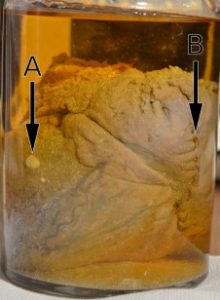Cardiovascular
Comments
In past years there were more studies on cardiac complications, particularly cor pulmonale when lung involvement was early and severe affecting most children and adolescents in the years before they died. The first report on cardiovascular manifestations of CF appeared in 1952 when the first few children survived for long enough to develop such complications (Nadas AS et al. Pediatrics 1952; 10:319-327. above).
As survival increases and people with CF can be expected to reach middle age and beyond it is timely that attention in again being given to the cardiac implications of many years of pulmonary disease and also perhaps to inherent cardiac abnormalities related to the CF.
In the early years of heart-lung transplantation in the Eighties, the so-called domino procedure, the heart from the CF recipient of the donor heart-lungs would be donated to a heart transplant recipient. It is interesting that the non-CF heart transplant recipients who received hearts from people with CF had a relatively good long term survival (76% at 5 years) – in fact better than patients who received hearts from non-CF patients (65% at 5 years) (Anyanwu AC et al. J Heart Lung Transplant 2002; 21:971-975.[PubMed]). This suggests that the heart from a severely affected person with CF who is a candidate for a heart lung transplant nevertheless appears to be suitable for use as a donor organ.
1951 Royce SW. Cor pulmonale in infancy and early childhood; report on 34 patients with special reference to the occurrence of pulmonary heart disease in cystic fibrosis of the pancreas. Pediatrics 1951; 8:255-274.[PubMed]
This paper by Stephen Royce of California and the subsequent publication by the paediatric cardiologist Alexander Nadas (Nadas et al, 1952 below) are early reports of cor pulmonale in children with CF who now were surviving for sufficient time for the cardiovascular problems secondary to severe lung disease to become evident. Seventy percent of children who died of chronic lung disease showed evidence of cor pulmonale at autopsy. Over half died in severe right sided heart failure and not surprisingly, therapy of the secondary heart problems was usually unsuccessful although understandably the complication received considerable attention as more children survived for longer periods.
1952 Nadas AS, Cogan G, Landing BH, Shwachman H. Studies in pancreatic fibrosis: cor pulmonale; clinical and pathologic observations. Pediatrics 1952; 10:319-327.[PubMed]
Alexander Nadas (1913 – 2000) of Harvard was described as the father of paediatric cardiology. This is another early report of cardiac complications in eight of 45 children aged six months to 17 years (17% of the patients); one died in right heart failure, the rest showed electrocardiographic changes of right ventricular hypertrophy. The authors suggested that cardiac complications may be an increasing problem with the efficiency of antibiotic treatment and increasing survival and this proved to be the case (also Royce, 1951 above).
1959 Holman RL, Blanc WA, Andersen D. Decreased aortic atherosclerosis in cystic fibrosis of the pancreas. Pediatrics 1959; 24:34-39.[PubMed]
At autopsy 21 non-CF control patients had four times the incidence of aortic atheroma (average percentage of the intimal surface involved with fatty streaks) than did 18 patients with CF aged six to 13 years.
The reasons were unknown and the authors did not think the simple explanation of fat malabsorption was the whole reason as other children dying from chronic malnutrition do not have this decreased incidence of atheroma. (also Moss TJ et al. J Pediatr 1979; 94:32-37. [PubMed]
2005 O’Mahony M. Skehan S. Gallagher C. Percutaneous stenting of the superior vena cava syndrome in a patient with cystic fibrosis. Irish Med J 2005; 98:85-86.[PubMed]
uperior vena cava (SVC) obstruction commonly occurs in the setting of malignancy. Cases of benign SVC obstruction are being seen more frequently with the use of long-term central venous lines. This is the case particularly in Cystic Fibrosis (CF). This report concerns the successful use of intravascular stenting to treat this distressing condition in the setting of thrombotic occlusion of the SVC in a patient with CF. This report is one of an increasing number of reports of complications associated with the use of totally implantable venous access devices.
2006 Montgomery GS, Sagel SD, Taylor AL, Abman SH. Effects of sildenafil on pulmonary hypertension and exercise tolerance in severe cystic fibrosis-related lung disease. Pediatr Pulmonol 2006; 41:383-385.[PubMed]
Cystic fibrosis (CF) patients with advanced lung disease are at risk for developing pulmonary vascular disease and pulmonary hypertension, characterized by progressive exercise intolerance beyond the exercise-limiting effects of airways disease in CF. This report concerns a patient with severe CF lung disease who experienced clinically significant improvements in exercise tolerance and pulmonary hypertension without changing lung function during sildenafil therapy.
Sildenafil has been reported to have a favourable effect on the DF508 mutation although no clinical trial had been reported by 2014. Here the drug is used to treat pulmonary hypertension which is common in severe CF lung disease.
2006 Garwood S, Flume PA, Ravenel J. Superior vena cava syndrome related to indwelling intravenous catheters in patients with cystic fibrosis. Pediatr Pulmonol 2006; 41:683-687.[PubMed]
Three patients with CF had superior vena cava syndrome (thrombosis in the large vein entering the heart) due to the presence in the vessel of a foreign body i.e. the implantable venous access device.
Although these devices proved to be a major overall advance since their introduction in the mid-Eighties, a variety of complications have been reported particularly if the devices are not cared for by experts – these include infection and various vascular clotting problems even paradoxical embolisation (Espiritu JD, Kleinhenz ME. Mayo Clin Proc 2000; 75:1100-1102. [PubMed]). Experience at CF centres shows that this particular complication is not rare and most have experienced one or two cases.
2008 Ghayyda SN, Roland D, Cade A. Seat belt associated central line fracture-a previously unreported complication in cystic fibrosis. J Cyst Fibros 2008; 7:448-449.[PubMed]
It is not routine practice to advise on seating position within the car in relationship to the seatbelt placement over the anterior chest wall. Line failure due to direct pressure from a seatbelt worn to prevent injury in the sudden deceleration involved during a motor vehicle accident (MVA) has not been described previously in the CF literature This report concerns the case of an 8 year old child who fractured her Vascuport(R) line secondary to seatbelt trauma following a road traffic accident. Children and adults with CF should be advised to sit in the car on the side that places the shoulder strap of the seatbelt on the opposite side to the TIVAD line.
This is a useful practical report which will help to prevent an unusual complication not previously reported.
2009 Hull JH, Garrod R, Ho TB, Knight RK, Cockcroft JR, Shale DJ, Bolton CE. Increased augmentation index in patients with cystic fibrosis. Eur Resp J 2009; 34:1322-1328. [PubMed]
Increased large artery stiffness occurs in a range of inflammatory conditions indicating an ageing of the vasculature and additionally being an independent risk factor for cardiovascular events. Augmentation index (AIx) is increased in adults with CF, in the presence of a normal blood pressure and independent of diabetic status. Fix was related to the systemic inflammatory status.
These findings have implications for management and require further exploration so that cardiovascular health can be maintained.
As more adults are studied new findings arise. This contrasts with a previous report that there was a reduction in atheroma in patients with CF.
2011 Labombard a F, Policier A, Alewife M, Caravel C, Ribault V, Laurans M, Guillot M, Bergot E, Grollier G, Milliez P, Zalcman G, Saloux E. Myocardial strain assessment in cystic fibrosis. J Am Soc Echocardiog 2011; 24:1037-1045.[PubMed]
The aim of this work was to evaluate myocardial strain analysis as a tool for the early detection of left ventricular functional changes in patients with cystic fibrosis. A total of 42 consecutive patients (mean age, 24 +/- 7.5 years; 52% men) diagnosed with cystic fibrosis and referred for echocardiographic cardiac function assessment were prospectively enrolled. A group of healthy age-matched and gender-matched volunteers (n= 42) formed the reference population for echocardiographic comparisons. Left ventricular ejection fraction was conserved in both groups but was significantly lower in the cystic fibrosis group. Cardiac function assessment using Doppler tissue imaging parameters revealed that both systolic and diastolic measurements differed between the two groups: mitral peak systolic and diastolic velocities, as well as septal and lateral wall strain rates, were decreased in patients with cystic fibrosis, as was longitudinal strain of both the septal and lateral walls. The authors concluded that using strain measurements, subclinical changes in left ventricular function were found in patients with cystic fibrosis. These parameters were correlated with the degree of pulmonary involvement severity. These findings have potentially significant clinical implications for the outcomes and follow-up of patients with cystic fibrosis, meriting further studies.
2012 Takemoto CM. Venous thromboembolism in cystic fibrosis. Pediatr Pulmonol 2012; 47:105-112. [PubMed].
The incidence of venous thromboembolism (VTE) is increasing in the pediatric population. Individuals with cystic fibrosis (CF) have an increased risk of thrombosis due to central venous catheters (CVCs), as well as acquired thrombophilia secondary to inflammation, or deficiencies of anticoagulant proteins due to vitamin K deficiency and/or liver dysfunction. CVC-associated thrombosis commonly results in line occlusion, but may develop into serious life-threatening conditions such as deep venous thrombosis (DVT), superior vena cava syndrome or pulmonary embolism (PE). Post-thrombotic syndrome (PTS) may be a long complication. Local occlusion of the catheter tip may be managed with instillation of thrombolytics (such as tPA) within the lumen of the catheter; however, CVC-associated thrombosis involving the proximal veins is most often is treated with systemic anticoagulation. Initial treatment with heparin is a standard approach, but thrombolytic therapy, which may carry higher bleeding risks, should be considered for life and limb threatening episodes of VTE. Recommended duration of anticoagulation with low molecular weight heparin (LMWH) or warfarin ranges from 3 to 6 months for major removable thrombotic risks; longer anticoagulation is considered for recurrent thrombosis, major persistent thrombophilia, or the continued presence of a major risk factor such as a CVC. While CVCs are the most common risk for development of VTE in children, studies have not demonstrated a clear benefit with routine use of systemic thromboprophylaxis. The incidence and risk factors of VTE in CF patients are reviewed and principles of diagnosis and management will be summarized.
A useful review of an uncommon but potentially serious complication in people with CF.
Dr Takemoto is Associate Professor of Pediatrics at The Johns Hopkins Hospital.
2013 Eaden J. Peckham D. Myocardial infarction in an adult with cystic fibrosis and heart and lung transplant. Multidscip Respir M 2013; 8:37. [PubMed]
We present a case of myocardial infarction in a 19 year old female with cystic fibrosis who had a heart and lung transplant performed at the age of four years old. She presented atypically with a one day history of severe, intermittent, central, sharp chest pain, radiating to her back and down her left arm. A coronary angiogram showed proximal stenosis of the left anterior descending artery and right coronary artery. She was treated with percutaneous coronary intervention, involving drug eluting stents to the left anterior descending artery (LAD) and the right coronary artery (RCA).
In this study the authors discuss the pathophysiology, investigations and treatment of cardiac transplant vasculopathy. Although complete reversal of LAD and RCA stenosis was achieved, routine follow-up with coronary angiography and careful control of cardiac risk factors will be important to identify and reduce future restenosis and adverse cardiac events
2013 van Doorn CS. De Boo DW. Weersink EJ. van Delden OM. Reekers JA. van Lienden KP. Permanent cortical blindness after bronchial artery embolization. Cardiovasc Intervent Radiol 2013; 36:1686-9.[PubMed]
A 35-year-old female with a known medical history of cystic fibrosis had a massive haemoptysis. CTA depicted a hypertrophied bronchial artery to the right upper lobe and showed signs of recent bleeding at that location. Bronchial artery embolization (BAE) was performed with gelfoam slurry, because pronounced shunting to the pulmonary artery was present. Immediately after BAE, the patient developed bilateral cortical blindness. Control angiography showed an initially not opacified anastomosis between the embolized bronchial artery and the right subclavian artery, near to the origin of the right vertebral artery. Cessation of outflow in the bronchial circulation reversed the flow through the anastomosis and allowed for spill of embolization material into the posterior circulation. Unfortunately the cortical blindness presented was permanent.
2013 Chan BK. Rupasinghe SN. Hennessey I. Peart I. Baillie CT. Retained central venous lines (CVLs) after attempted removal: an 11-year series and literature review. J Pediatr Surg 2013; 48:1887-91. [PubMed]
This paper documents the incidence and management of retained CVLs in a tertiary pediatric surgical centre with access to interventional cardiology services. Children with retained CVLs were identified from departmental morbidity and mortality records over an 11-year period. The 11-year incidence of retained CVL was 0.3% (n=10; median duration in-situ 66.5 {range 47-146} months). The underlying pathology in 8 was cystic fibrosis. Antegrade transfemoral snare retrieval was successful in 6 of 7 attempts. In the remaining 3, a conservative approach was adopted following consultation with the family. None of the 4 with retained CVL developed complications (median follow-up 7.5 {range 1-53} months). The literature describes 38 pediatric index cases (including 10 from the current series). Seventeen (49%) were managed conservatively either intentionally or by default after failed endovascular removal attempt (n=4). No complications directly attributed to retained CVLs have been reported (median follow-up 40 {range 1-120} months). Reported morbidity associated with endovascular retrieval includes: procedural failure 30%, line embolization 8%, and intra-operative thrombo-embolism 8%.
The authors observed that literature regarding management of retained CVLs is anecdotal. Although uncommon, the complication should feature in consent for removal of CVLs. Conservative management carries long-term risks of infection, thrombosis, and even migration, albeit unquantified over a child’s lifetime. Endovascular retrieval is feasible with appropriate expertise.
2015 Wormser B. 50 Years Ago in The Journal of Pediatrics: Cor Pulmonale in Cystic Fibrosis of the Pancreas. J Pediatrics 2015; 167(5):1080. [PubMed] (Discussing – Moss AJ, Harper WH, Dooley RR, Murray JF, Mack JF. J Pediatr 1965;67:797-807)
Moss et al published their work 19years after the medical community first recognized the phenomenon of pulmonary hypertension in patients with cystic fibrosis. This squeeze of the pulmonary vasculature had been attributed to hypoxemia and cor pulmonale, its sequelae, had been recognized as a major cause of death for patients with cystic fibrosis.This study aimed to improve the ability to detect pulmonary hypertension and cor pulmonale for prognostic purposes. This included an evaluation of the noninvasive technology available at the time. Their study of 21 stable patients with cystic fibrosis indicated that none of the available techniques (which included electrocardiogram, vectorcardiogram, chest radiograph, and vital capacity) could reliably predict the presence of cor pulmonale. This left only cardiac catheterization, the gold standard both then and now.Over the next 50years, our understanding of pulmonary hypertension in cystic fibrosis and other chronic pulmonary diseases has progressed, yielding an understanding of the chronic systemic inflammation and pulmonary vascular bed remodeling that occurs in these patients to create the phenomenon of pulmonary hypertension. We have created new means of examining our patients’ hearts with noninvasive techniques such as Doppler echocardiography 1 and cardiac magnetic resonance imaging. Our treatment goals have evolved with our diagnostic technology and today, our studies of pulmonary hypertension in cystic fibrosis reflect that shift. Current research focuses on the outcomes of patients with pulmonary hypertension following lung transplantation. Recent analyses of the United Network for Organ Sharing registry modernized our knowledge by demonstrating that patients with severe pulmonary hypertension still have lower survival rates than those with mild hypertension, but that the existence of pulmonary hypertension does not affect post-transplant survival. 2 In the next 50years, the success of gene therapy and new medications already being tested will aim to make the discussion of pulmonary hypertension in patients with cystic fibrosis a vestige of medical history.
Belle-van Meerkerk G., Cramer M.J., Kwakkel-van Erp J.M., Nugroho M.A., Tahri S., de Valk H.W., et al: Pulmonary hypertension is a mild comorbidity in end-stage cystic fibrosis patients. J Heart Lung Transplant 2013; 32: pp. 609-6142. Hayes D., Tobias J.D., Mansour H.M., Kirkby S., McCoy K.S., Daniels C.J., et al: Pulmonary hypertension in cystic fibrosis with advanced lung disease. Am J Respir Crit Care Med 2014; 190: pp. 895- 905
– An interesting review of the changing approach to pulmonary hypertension in people with CF.
2016 Lenehan PJ; Schramm CM; Collins MS. An evaluation strategy for potential QTc prolongation with chronic azithromycin therapy in cystic fibrosis. J Cyst Fibros 2016; 15(2):192-5. [PubMed]
Chronic azithromycin therapy is recommended for CF patients with persistent Pseudomonas aeruginosa colonization. Other macrolide antibiotics have been reported to cause QT prolongation, but cardiac effects of azithromycin have not been studied in pediatric populations. The authors analysed changes in QTc interval after starting chronic azithromycin in a pediatric CF population. Adolescent males showed increased QTc intervals after initiation of therapy.
Given the possible effects of azithromycin on the QTc interval, particularly in patients predisposed to cardiac events, the authors suggest that the QTc interval of CF patients should be monitored throughout the course of chronic azithromycin.
2016 Labombarda F, Saloux E, Brouard J, Bergot E, Milliez P. Heart involvement in cystic fibrosis: A specific cystic fibrosis-related myocardial changes? Respir Med. 2016 Sep;118:31-8. doi: 10.1016/j.rmed.2016.07.011. Epub 2016 Jul 15. [PubMed]
Over the last four decades pathological, experimental, and clinical evidence points towards the existence of a specific myocardial involvement in cystic fibrosis. Multi-modality cardiac imaging, especially recent echocardiographic techniques, evidenced diastolic and/or systolic ventricular dysfunction in cystic fibrosis leading to the concept of a cystic fibrosis-related cardiomyopathy. Hypoxaemia and inflammation are among the most important factors for heart involvement in cystic fibrosis. Cystic Fibrosis Transmembrane Regulator was found to be involved in the regulation of cardiomyocyte contraction and may also account for cystic fibrosis-related myocardial dysfunction.
– This review, mainly focused on echocardiographic studies, seeks to synthesise the existing literature for and against the existence of heart involvement in cystic fibrosis, its mechanisms and prognostic implications. Careful investigation of the heart function may be helpful for risk stratification and therapeutic decisions in patients with cystic fibrosis.
2016 Rodriguez-Miguelez P, Thomas J, Seigler N, Crandall R, McKie KT, Forseen C, Harris RA. Evidence of microvascular dysfunction in patients with cystic fibrosis. Am J Physiol Heart Circ Physiol. 2016 Jun 1;310(11):H1479-85. doi: 10.1152/ajpheart.00136.2016. Epub 2016 Apr 15. [PubMed]

Ryan Harris
Recent findings have described impairment in conduit vessel function in patients with CF; however, whether microvascular function is affected in this population has yet to be elucidated. Using laser-Doppler imaging, the authors evaluated microvascular function through post occlusive reactive hyperaemia (PORH), local thermal hyperaemia (LTH), and iontophoresis with acetylcholine (ACh). PORH [518 ± 174% (CF) and 801 ± 125% (control), P = 0.039], LTH [1,338 ± 436% (CF) and 1,574 ± 620% (control), P = 0.045], and iontophoresis with ACh [416 ± 140% (CF) and 617 ± 143% (control), P = 0.032] were significantly lower in patients with CF than control subjects.
In addition, the ratio of PORH to LTH was significantly (P = 0.043) lower in patients with CF (55.3 ± 5.1%) than control subjects (68.8 ± 3.1%). Significant positive correlations between LTH and forced expiratory volume in 1 s (%predicted) (r = 0.441, P = 0.013) and between the PORH-to-LTH ratio and exercise capacity (r = 0.350, P = 0.049) were observed.
– These data provide evidence of microvascular dysfunction in patients with CF compared with control subjects. In addition, the data demonstrate a complex relationship between microvascular function and classical markers of disease severity (i.e., pulmonary function and exercise capacity) in CF.
Dr Paula Rodriguez-Miguelez is Postdoctoral Fellow, Georgia Prevention Institute, Augusta University
Dr Ryan Harris (figure) is Director, Laboratory of Integrative Vascular and Exercise Physiology and Associate Professor, Pediatrics, Physiology and Graduate Studies
2016 Sismanlar T; Aslan AT; Kose M; Pekcan S; Ezgu FS; Budakoglu II; Yenicesu I. Early severe anemia as the first sign of cystic fibrosis. Eur J Pediatr 2016; 175(9):1157-63. [PubMed]
Severe anaemia as the first sign of CF was noted in 17 of 231 patients. Patient age, prolonged PT/INR and the albumin level differed significantly between the 2 groups of patients (P < 0.001). Feeding pattern, pancreatic insufficiency, vitamin E and A levels, and the types of genetic mutations did not differ between the 2 groups. The mean haemoglobin level was 5.59 +/- 0.21 g/dL and respiratory symptoms began a mean 6.3 months after diagnosis of CF in the anaemia group. In early infancy severe anaemia in the absence of respiratory symptoms can be the first sign of CF. CF should be considered in the differential diagnosis of severe anaemia in infants. Anaemia can occur several months before respiratory symptoms in patients with CF and may be caused due to several reasons
– These anaemic CF infants were not screened in the neonatal period. Extensive investigation showed the anemia was not primarily due to iron deficiency, vitamin E or Vitamin A deficiency. The authors concluded that the most important characteristics of the anemia were hypoalbuminemia suggesting that ineffective erythropoiesis due to general protein energy malnutrition might cause the anemia in these patients. So the complication should not be observed in early-treated screened CF infants.
2016 Skolnik K, Levy RD, Wilcox PG, Quon BS. Coronary artery disease in cystic fibrosis: An emerging concern? J Cyst Fibros. 2016 Nov;15(6):e70-e71. doi: 10.1016/j.jcf.2016.09.010. Epub 2016 Oct 14. [PubMed]
Between 1996 and 2016 and 16 patients 40 years and older, 14 (88%) underwent coronary angiography. The coronary angiography reports and “still” diagrams were carefully reviewed for evidence of luminal narrowing or complete obstruction of the coronary vessels consistent with atherosclerosis. Interestingly, no vessels had evidence of narrowing and not a single atherosclerotic plaque was documented in the 14 patients examined. Overall, this data is reassuring as natural history studies have shown that atherosclerotic changes often appear in coronary arteries years and sometimes decades before the onset of clinically significant coronary heart disease.
– Previously it has been suggested the infrequency of coronary artery disease ion people with CF is related to the low levels of serum lipids. In an earlier study 20 hearts from people with CF who were receiving heart-lung transplants were used for domino transplants for heart recipients. No coronary artery disease was present in 12 of these recipients who had angiography at 1 year (Jacob M H et al 1990. [PubMed])
2016 Van Iterson EH, Wheatley CM, Baker SE, Morgan WJ, Snyder EM. The relationship between cardiac haemodynamics and exercise tolerance in cystic fibrosis. Heart Lung 2016 (May-Jun);45(3):283-90. doi: 10.1016/j.hrtlng.2016.03.001. Epub 2016 Apr 1.[PubMed]
Individuals with cystic fibrosis (CF) have reduced pulmonary function and exercise tolerance. Additionally, these individuals may develop abnormal cardiac function. The implications of abnormal cardiac function on exercise tolerance are unclear in CF. Aim was to study relationships between exercise, cardiac haemodynamics and exercise tolerance in CF. 17 CF and 25 controls participated in cardiopulmonary exercise testing to measure exercise duration and peak workload (PW). Cardiac index (QI) was measured using acetylene rebreathe and oxygen uptake (VO2) breath-by-breath. Forced expiratory volume in 1-second (FEV1) was performed at rest. Peak QI was 6.7 ± 0.5 vs. 9.1 ± 0.3 mL/min/m(2), CF vs. controls, respectively (P < 0.05). Linear regressions between QI (R(2) = 0.63 and 0.51) and exercise duration or PW were stronger than VO2 (R(2) = 0.35 and 0.37) or FEV1 (R(2) = 0.34 and 0.36) in CF, respectively (P < 0.05).
These data are clinically relevant suggesting attenuated cardiac function in addition to low airway function relate to exercise tolerance in CF.
– In the Sixties, when more children with CF were surviving childhood with chronic respiratory problems, there was increasing interest in secondary cardiac problems including pulmonary hypertension. Interest seems to be now to be focusing on other areas such as the nervous system and cardiovascular system. It is interesting that in the early days of transplantation in the Eighties, the so-called domino procedure used the heart of the CF recipient of a heart-lung transplant for a heart transplant for a non-CF recipient. The use of domino hearts donated by CF recipients of heart-lung transplants is beneficial and is associated with an excellent early and longer-term outcome (Smith JA et al. Eur J Cardiothorac Surg 1996; 10(8):628-33 [PubMed]).
2017 Sayyid ZN, Sellers ZM. Technological advances shed light on left ventricular cardiac disturbances in cystic fibrosis. J Cyst Fibros. 2017 Jul;16(4):454-464. doi: 10.1016/j.jcf.2017.02.013. Epub 2017 Mar 14. [Pubmed]
Clinical heart disease in CF is considered rare and is restricted to case reports. It has been unclear if this is due to the lack of physiological importance of CFTR in the heart, the relatively short lifespan of those with CF, or a technical inability to detect subclinical disease. The authors focus on data from new echocardiographic and magnetic resonance imaging technology, which are providing greater insight into cardiac function in CF and demonstrating that, in addition to secondary effects from pulmonary disease, there may be an intrinsic primary defect in the CF heart. With advancing lifespans and activity levels, understanding the risk of cardiac disease is vital to minimising morbidity in adults with CF.
– A detailed review of cardiac involvement in CF. One recalls in the domino transplant procedures of the Eighties, the heart of the CF recipient of the heart lung transplant was used successfully for another non-CF patient requiring a heart transplant. The actuarial survival of the recipients of these transplanted CF hearts was 75% at 1 year. No coronary artery disease was present in the 12 patients who underwent coronary angiography at 1 year (Yacoub MH et al, 1990 [Pubmed])
2017 Town JA; Aitken ML. Deaths Related to Bronchial Arterial Embolization in Patients With Cystic Fibrosis: Three Cases and an Institutional Review. Chest. 150(4):e93-e98, 2016 Oct [Pubmed]
The outcomes after BAE for hemoptysis in CF and present three cases highlighting this complication. From 2007 to 2015, 12 patients underwent 17 BAE procedures for hemoptysis at our institution. Three patients experienced respiratory failure and died within 3 months of BAE. Non-survivors had significantly lower baseline FEV1 values than survivors (21.8% vs. 52.6%, P <.05). BAE as a treatment for life-threatening hemoptysis may precipitate respiratory failure in end-stage CF and should accelerate the evaluation for lung transplantation.
The authors advise that institutions should re-evaluate their BAE practices to ensure preservation of the bronchial circulation, which contributes to gas exchange in these patients.
2018 Hussain N, Hussain F, Malik A, Rizvi M, Patel P, Chittivelu S. A devastating cardiovascular event in an adult cystic fibrosis patient: An unforeseen outcome of increasing life expectancy. Respir Med Case Rep. 2018 Sep 21;25:233-234. doi: 10.1016/j.rmcr.2018.09.013. eCollection 2018. Free full text [Pubmed]

Noreen Hussain
As the life expectancy of CF patients has increased, it is important to consider other co-morbidities that these patients may encounter, and the impact this may have on their morbidity and mortality. We present a case of a 33-year-old male admitted to the hospital for a CF exacerbation who had an acute neurological decompensation due to an infarction of his right occipital and posterior temporal lobe
Noreen Hussain is at the Department of Internal Medicine; University of Illinois College of Medicine at Peoria, USA.
Pallin M, Keating D, Kaye DM, Kotsimbos T, Wilson JW.Subclinical Left Ventricular Dysfunction is Influenced by Genotype Severity in Patients with Cystic Fibrosis.Clin Med Insights Circ Respir Pulm Med. 2018 Aug 19;12:1179548418794154. doi: 10.1177/1179548418794154. eCollection 2018. Free PMC Article [Pubmed]
Over 2000 genotypes in the cystic fibrosis (CF) gene have been described. These genotypic differences result in variable clinical manifestations of CF, with severity of disease dependent on CF transmembrane conductance (CFTR) protein function. CFTR is widely distributed in nucleated cells, including cardiac myocytes, but the effect of genotype on cardiac function. This retrospective review of echocardiographic data is from a single adult CF centre between 2000 and 2015. Patients were cohorted based on the functional classification of genotype. ‘Severe’ patients had both CF genes from functional classification groups 1-3; ‘mild’ patients had one or no gene from these groups, or in the event of the second gene being unknown were pancreatic sufficient. Genotype and echocardiography were recorded during the inclusion period in 100 patients, 79 of whom were classified as having severe genotypes.
Although the severe group were younger they had a lower fractional shortening (33.66 ± 6.6 vs 36.9 ± 6.3, P < .05), left atrial area (14.9 ± 3.6 versus 18.0 ± 4.2 cm2; P < .01) and volume (39.9 ± 18.7 versus 51.0 ± 18.7 mL; P < .05) and showed a trend to lower left ventricular ejection fraction. This study is the first to show that in CF, severity of genotype (functional classification) is associated with cardiac impairment. Patients with severe CF genotype and cardiac dysfunction should be identified to evaluate cardiac response to gene-modifying treatments prior to consideration for lung transplantation.
From the Cystic Fibrosis Service, Alfred Health and Central Clinical School, Monash University, Melbourne, VIC, Australia.
Rodriguez Miguelez P, Seigler N, Tucker MA, Csanyi G, McKie KT, Forseen C, Harris RA. Sildenafil improves vascular endothelial function in patients with cystic fibrosis. Am J Physiol Heart Circ Physiol. 2018 Aug 31. doi: 10.1152/ajpheart.00301.2018. [Epub ahead of print] [Pubmed]

Paula Rodriguez-Miguelez
Cystic fibrosis (CF), characterized by defective CFTR function, is associated with multiple systemic complications including vascular dysfunction. Sildenafil, a phosphodiesterase type 5 (PDE5) inhibitor, not only enhances nitric oxide (NO) metabolism, it has been shown to improve CFTR functionality as well. Thus, sildenafil has been proposed as a potential therapy to improve vascular health in CF; however, its potential therapeutic role has yet to be determined.
To investigate the effect of sildenafil treatment on endothelial function in patients with CF.
Patients with CF completed a randomized, double blind, placebo controlled, crossover study with an acute dose of sildenafil (50 mg) and placebo followed by a four-week, open label extension with sildenafil (20 mg/day). Flow-mediated dilation (FMD) was used to evaluate endothelial function before and after treatments. In addition, phosphorylated (p) and total endothelial NO synthase (NOS3) protein expression was determined from endothelial cells that were exposed to plasma from the patients before and after four weeks of sildenafil.
No changes (p≥0.110) in endothelial function were observed after the acute dose of sildenafil. However, FMD significantly (p=0.029) increased after four weeks of treatment (∆FMD= 1.5 ± 2.2%). Moreover, p-NOS3 protein expression significantly (p=0.013) increased following 4 weeks of treatment (∆p-NOS3= 0.31 ± 0.39 AU) and was associated (r=0.593; p=0.033) with the observed change in FMD.
These data suggest that four weeks of sildenafil treatment can improve vascular endothelial function in patients with CF, likely through an increase in NOS3 phosphorylation.
Paula Rodriguez-Miguelez is Assistant Professor of Health Science, Department of Kinesiology and Health Sciences at Virginia Commonwealth University, Richmond
THE FOLLOWING FOUR RECENT ABSTRACTS CONCERN CHOPIN’S HEART AND SO ARE PLACED TOGETHER
Witt M, Szklener A, Kawecki J, Rużyłło W, Negrusz-Kawecka M, Jeleń M, Langfort R, Marchwica W, Dobosz T. A Closer Look at Frederic Chopin’s Cause of Death. Am J Med. 2018 Feb;131(2):211-212. doi: 10.1016/j.amjmed.2017.09.039. Epub 2017 Oct 12. [Pubmed]

Michal Witt
On the basis of visual analysis of Chopin’s heart the authors concluded that he died from long lasting tuberculosis as the primary disease causing progressive deterioration his physical condition. Tuberculous pericarditis progressing rapidly may have been the cause of death.

Chopin’s heart
Prof. Michael Witt has been head of the Division of Molecular and Clinical Genetics, Institute of Human Genetics, Polish Academy of Sciences for many years. Since 1999 Deputy Director at the International Institute of Molecular and Cell Biology Warsaw.
Professor Witt told the Observer “Some people still want to open it (the jar) in order to take tissue samples to do DNA tests to support their ideas that Chopin had some kind of genetic condition. Witt said.”That would be absolutely wrong. It could destroy the heart and in any case I am quite sure we now know what killed Chopin.”
Perciaccante A, Charlier P, Negri C, Coralli A, Appenzeller O, Bianucci R. Did Frédéric Chopin Die From Heart Failure?J Card Fail. 2018 Mar 26. pii: S1071-9164(18)30122-2. doi: 10.1016/j.cardfail.2018.03.009. [Epub ahead of print] [Pubmed]

Antonio Perciaccant
On October 17, 1849, Poland’s greatest composer, Frédéric Chopin (1810-1849) died aged 39. His cause of death remains unknown. An investigation of the documental sources was performed to reconstruct the medical history of the artist. Since his earliest years, his life had been dominated by poor health. Recurrent episodes of cough, fever, headaches, lymphadenopathy- a series of symptoms that may be attributed to viral respiratory infections- manifested in his teens. Later in life, he had chest pain, haemoptysis, hematemesis, neuralgia, and arthralgia. Exhaustion and breathlessness characterized all his adult life. Coughing, choking, and oedema of the legs and ankles manifested four months before his death. Several hypotheses ranging from cystic fibrosis to alpha-1 anti-trypsin deficiency and pulmonary tuberculosis have been proposed to explain Chopin’s lifelong illness.
These authors suggest that Chopin had dilated cardiomyopathy with consequent heart failure and cirrhosis that caused his death..
Antonio Perciaccante (figure) is from the Department of Medicine San Giovanni di Dio Hospital, Gorizia, Italy
Charlier P, Perciaccante A, Herbin M, Appenzeller O, Bianucci R. The Heart of Frederic Chopin (1810-1849).Am J Med. 2018 Apr;131(4):e173-e174. doi: 10.1016/j.amjmed.2017.12.005. [Pubmed]

Phillipe Charlier
The authors are critical of the conclusions in the paper of Witt et al 2017 where tuberculous (TB) pericarditis coupled with massive enlargement of the right ventricle, possibly due to pulmonary hypertension, was proposed as the most plausible cause of death of the artist based on three nodules not examined histologically. They consider a retrospective diagnosis of TB pericarditis cannot be made with confidence.
Philippe Charlier is Head of the Section of Medical and a Forensic Anthropology, Université de Versailles Saint-Quentin. An article in the New York Times states that Dr. Charlier “does not confine himself to his closet of a laboratory at the hospital here. He writes books, makes television documentaries and does radio broadcasts to popularize his findings, which has earned him the title of “Indiana Jones of the graveyards.”
Duclos-Vallée JC, Erlinger S. Is Frederic Chopin’s Death Elucidated? Am J Med. 2018 Apr;131(4):e171. doi: 10.1016/j.amjmed.2017.11.041. No abstract available [Pubmed]

Jean Charles Duclos Vallee
These authors consider that clinical presentation of Chopin’s chronic disease is not typical of tuberculosis as there appeared to be complete recovery between episodes of respiratory illness. Also he had been examined by Laennec who did not diagnose tuberculosis. The authors mention other hypotheses including a1-antitrypsin deficiency for which there a reasonable case. As the original autopsy report of Prof. jean Cruveilhier was lost the article of Witt et al brings important new information to the immediate cause of Chopin’s death. Apparently Cruveilhier pulled out the heart, which was then transported to Warsaw by Chopin’s sister
These authors “think more data would be useful specifically a genetic analysis to exclude or confirm once and for all the diagnosis of a1- antitrypsin deficiency.
Wu H, Vu M, Dhingra S, Ackah R, Goss JA, Rana A, Quintanilla N, Patel K, Leung DH. Obliterative Portal Venopathy without Cirrhosis is Prevalent in Pediatric Cystic Fibrosis Liver Disease with Portal Hypertension. Clin Gastroenterol Hepatol. 2018 Nov 4. pii: S1542-3565(18)31213-8. doi: 10.1016/j.cgh.2018.10.046. [Epub ahead of print] [Pubmed]

Hao Wu
Cystic fibrosis liver disease (CFLD) has long been postulated to be secondary to dysfunctional CFTR (CF transmembrane conductance regulator) in the apical biliary epithelium leading to bile stasis and eventually cirrhosis with portal hypertension. However, pathological changes in the CF liver are distinct from the pancreas and lungs in that fibrocystic changes are absent.
17 CF patients (8 M) underwent liver transplantation for portal hypertension at a median age of 15.0 years (range: 8.8-20.0). All patients were pancreatic insufficient with pulmonary colonization of emerging CF pathogens. 88.2% had splenomegaly with thrombocytopenia and esophageal varices were endoscopically confirmed in 94.1%. No patients experienced hepatic encephalopathy, or jaundice related to liver disease. Conjugated bilirubin levels were normal in all, and alkaline phosphatase levels were normal in 76%. Median AST to platelet ratio index, fibrosis-4, and gamma glutamyltransferase were 1.14, 1.20, and 71 U/L, respectively.
The authors identified obliterative portal venopathy and nodular regenerative hyperplasia in the explanted livers of CF children with portal hypertension making the histologic distinction determining the decision as to shunt or transplant. They suggest lack of cirrhosis and absent cholestasis challenges the long and widely held accepted theory that biliary CFTR dysfunction is the predominant mechanism underlying cystic fibrosis liver disease. (There are helpful illustrations of affected livers in the main text).
Dr Hao Wu is Assistant Professor in the Department of Pathology, Baylor College of Medicine and Texas Hospital
2019 Bisch AL, Wheatley CM, Baker SE, Peitzman ER, Van Iterson EH, Laguna TA, Morgan WJ, Snyder EM. Cystic Fibrosis Transmembrane Conductance Regulator Genotype, Not Circulating Catecholamines, Influences Cardiovascular Function in Patients with Cystic Fibrosis. Clin Med Insights Circ Respir Pulm Med. 2019 Mar 29;13:1179548419835788. doi: 10.1177/1179548419835788. eCollection 2019. Free PMC article [Pubmed]

Eric Snyder
Cystic fibrosis (CF) is a genetic disease affecting multiple organ systems of the body and is characterized by mutation in the gene coding for the cystic fibrosis transmembrane conductance regulator (CFTR). Previous work has shown that a single dose of aβ-agonist increases cardiac output (Q) and stroke volume (SV) and decreases systemic vascular resistance (SVR) in healthy subjects. This effect is attenuated in patients with CF; however, the mechanism is unknown. Potential explanations for this decreased cardiovascular response to a β-agonist in CF include inherent cardiovascular deficits secondary to the CFTR mutation, receptor desensitization from prolonged β-agonist use as part of clinical care, or inhibited drug delivery to the bloodstream due to mucus buildup in the lungs. This study sought to determine the effects of endogenous epinephrine (EPI) and norepinephrine (NE) on cardiovascular function in CF and to evaluate the relationship between cardiovascular function and CFTR F508del mutation.
A total of 19 patients with CF and 31 healthy control subjects completed an assessment of Q (C2H2 rebreathing), SV (calculated from Q and heart rate [HR]), Q and SV indexed to body surface area (BSA, QI, and SVI, respectively), SVR (through assessment of Q and mean arterial blood pressure [MAP]), and HR (from 12-lead electrocardiogram [ECG]) at rest along with plasma measures of EPI and NE. We compared subjects by variables of cardiovascular function relative to EPI and NE, and also based on genetic variants of the F508del mutation (homozygous deletion for F508del, heterozygous deletion for F508del, or no deletion of F508del).
Cystic fibrosis patients demonstrated significantly lower BSA (CF = 1.71 ± 0.05 m2 vs healthy = 1.84 ± 0.04 m2, P = .03) and SVI (CF = 30.6 ± 2.5 mL/beat/m2 vs healthy = 39.9 ± 2.5 mL/beat/m2, P = .02) when compared with healthy subjects. Cystic fibrosis patients also demonstrated lower Q (CF = 4.58 ± 0.36 L/min vs healthy = 5.71 ± 0.32 L/min, P = .03) and SV (CF = 54 ± 5.5 mL/beat vs healthy = 73.3 ± 4.5 mL/beat, P = .01), and a higher HR (CF = 93.2 ± 3.9 bpm vs healthy = 80.5 ± 2.7 bpm, P < .01) and SVR (CF = 2082 ± 156 dynes*s/cm-5 vs healthy = 1616 ± 74 dynes*s/cm-5, P = .01) compared with healthy subjects. Furthermore, CF patients demonstrated a lower SV (P < .01) corrected for NE when compared with healthy subjects. No significant differences were seen in HR or Q relative to NE, or SVR relative to EPI. Differences were seen in SV (F(2,14) = 7.982, P < .01) and SV index (F(2,14) = 2.913, P = .08) when patients with CF were stratified according to F508del mutation (number of deletions).
The authors concluded that individuals with CF have lower cardiac and peripheral hemodynamic function parameters at rest. Furthermore, these results suggest that impairment in cardiovascular function is likely the result of F508del CFTR genotype, rather than receptor desensitization or inhibited drug delivery.
From a Thesis by Alexander Louis Bisch Department of Kinesiology, University of Minnesota, Minneapolis, MN, USA Advisor was Dr Eric M Snyder Assistant Professor and Director, Clinical Exercise Physiology Laboratory
2019 Avedissian SN, Rhodes NJ, Ng TMH, Rao AP, Beringer PM.The Potential for QTc Prolongation with Chronic Azithromycin Therapy in Adult Cystic Fibrosis Patients.Pharmacotherapy. 2019 May 2. doi: 10.1002/phar.2270. [Epub ahead of print] [Pubmed]
Oral azithromycn (AZM) has been shown to reduce airway inflammation and disrupt biofilm formation. However, chronic AZM therapy may result in QT interval (QTc) prolongation. The goals of this study were twofold: 1) to characterize the risk of QTc prolongation in adult cystic fibrosis (CF) patients on AZM and other potential QTc prolonging agents, and 2) to describe and capture the number of potential QTc prolonging agents CF patients are prescribed. A retrospective study was conducted over a 3-year period in an adult CF Center. QTc values were recorded from electrocardiograms. Univariate and multivariate analyses were conducted. Standard QTc prolongation definitions (Males: ≥ 450 msec, Female: ≥ 470 msec) were used.
A total of 89 adult CF patient’s records were reviewed. Sixty-eight patients received chronic AZM therapy. Two male patients had prolonged QTc, but only 1 received chronic AZM therapy. The median QTc interval between patients receiving and not receiving AZM was not significantly different (405 [interquartile range, IQR: 388-425] versus 394 [IQR:384-413] msec, respectively, P=0.14). Also, the QTc interval for patients taking chronic AZM 500mg Monday/Wednesday/Friday or 250mg daily was not significantly different (401 [IQR: 383-419] versus 409 [IQR:394-427] msec, respectively, P=0.48). When stratified by the number of QTc prolonging medications (AZM vs no AZM), there was no significant difference in median QTc values between patients receiving zero to ≥ 5 QTc prolonging medications.
The authors concluded an association between chronic AZM therapy and longer QTc intervals or significant QTc prolongation was not shown in this study
Sean N Avedissian is in the Department of Pharmacy Practice, Midwestern University, Chicago
– The early literature up to 2014 has been reviewed by Albert RK, Schuller JL AJRCCM 2014; 189(10) PubMed 24707986. Their summary describes the electrophysiological effects of macrolides, reviews literature indicating that the large majority of subjects experiencing cardiac arrhythmias from macrolides have coexisting risk factors and that the incidence of arrhythmias in absence of coexisting risk factors is very low, examines recently published studies describing the relative risk of arrhythmias from macrolides, and concludes that this risk has been overestimated and suggests an approach to patient evaluation that should reduce the relative risk and the incidence of arrhythmias to the point that chronic macrolides can be used safely in the majority of subjects for whom they are recommended. Indeed they are still being recommended and prescribed for people with CF.
Bakhshayeshkaram M, Aghahosseini F, Vaezi F, Kahkooei S, Salehi Y, Hassanzad M, Jamaati HR, Velayati AA.CT-measured pulmonary artery diameter as an independent predictor of pulmonary hypertension in cystic fibrosis. Pol J Radiol. 2018 Aug 23;83:e401-e406. doi: 10.5114/pjr.2018.79204. eCollection 2018. [Pubmed]
The aim of the present study was to evaluate the diagnostic performance of thoracic vascular parameters on CT to detect pulmonary hypertension (PH). CF patients who contemporaneously underwent CT and echocardiography were retrospectively enrolled. Baseline characteristics in addition to pulmonary artery diameter (PAD) and pulmonary to aortic (PA/A) ratio were compared between cohorts with and without PH, based on the results of echocardiography separately in paediatric patients (< 18) and adults (≥ 18).
Of a total 119 CF patients, 39 (32.8%) had PH (paediatric: 23/78, 29.5%, adult: 16/41, 39%). In paediatric CF patients, mean age, HCo3, PCo2, and pulmonary artery diameter (PAD) were significantly higher in the PH group compared to the non-PH group. Mean pulmo however, only PAD remained as the independent predictor of PH based on multivariate analysis (overall: 22.86 mm [±3.86] vs. 18.43 mm [±4.72], p = 0.005, paediatric patients: 22.63 mm [±4.4] vs. 17.10 mm [±4.64], p = 0.03). Using a cut off of 19.25 mm, the diagnostic performance of PAD to detect PH was found to be as follows: sensitivity = 82%, specificity = 70%, and accuracy = 73.1%. No significant difference was demonstrated in PAD between PH and non-PH groups in adults with CF (23.19 [±3.60] vs. 21.34 [±3.49], p = 0.7).
In CF patients, PAD revealed an age-dependent performance to detect PH. PAD can be applied to predict pulmonary hypertension in paediatric CF patients and may be recommended to be routinely measured on follow-up chest CT scan in childhood CF.
Bisch AL, Wheatley CM, Baker SE, Peitzman ER, Van Iterson EH, Laguna TA, Morgan WJ, Snyder EM. Cystic Fibrosis Transmembrane Conductance Regulator Genotype, Not Circulating Catecholamines, Influences Cardiovascular Function in Patients with Cystic Fibrosis.Clin Med Insights Circ Respir Pulm Med. 2019 Mar 29;13:1179548419835788. doi: 10.1177/1179548419835788. eCollection 2019.[Pubmed] Free PMC Article
Previous work has shown that a single dose of aβ-agonist increases cardiac output (Q) and stroke volume (SV) and decreases systemic vascular resistance (SVR) in healthy subjects. This effect is attenuated in patients with CF; however, the mechanism is unknown. Potential explanations for this decreased cardiovascular response to a β-agonist in CF include inherent cardiovascular deficits secondary to the CFTR mutation, receptor desensitization from prolonged β-agonist use as part of clinical care, or inhibited drug delivery to the bloodstream due to mucus buildup in the lungs. This study sought to determine the effects of endogenous epinephrine (EPI) and norepinephrine (NE) on cardiovascular function in CF and to evaluate the relationship between cardiovascular function and CFTR F508del mutation.
A total of 19 patients with CF and 31 healthy control subjects completed an assessment of Q (C2H2 rebreathing), SV (calculated from Q and heart rate [HR]), Q and SV indexed to body surface area (BSA, QI, and SVI, respectively), SVR (through assessment of Q and mean arterial blood pressure [MAP]), and HR (from 12-lead electrocardiogram [ECG]) at rest along with plasma measures of EPI and NE. We compared subjects by variables of cardiovascular function relative to EPI and NE, and also based on genetic variants of the F508del mutation (homozygous deletion for F508del, heterozygous deletion for F508del, or no deletion of F508del).

Dr Eric Snyder
Cystic fibrosis patients demonstrated significantly lower BSA (CF = 1.71 ± 0.05 m2 vs healthy = 1.84 ± 0.04 m2, P = .03) and SVI (CF = 30.6 ± 2.5 mL/beat/m2 vs healthy = 39.9 ± 2.5 mL/beat/m2, P = .02) when compared with healthy subjects. Cystic fibrosis patients also demonstrated lower Q (CF = 4.58 ± 0.36 L/min vs healthy = 5.71 ± 0.32 L/min, P = .03) and SV (CF = 54 ± 5.5 mL/beat vs healthy = 73.3 ± 4.5 mL/beat, P = .01), and a higher HR (CF = 93.2 ± 3.9 bpm vs healthy = 80.5 ± 2.7 bpm, P < .01) and SVR (CF = 2082 ± 156 dynes*s/cm-5 vs healthy = 1616 ± 74 dynes*s/cm-5, P = .01) compared with healthy subjects. Furthermore, CF patients demonstrated a lower SV (P < .01) corrected for NE when compared with healthy subjects. No significant differences were seen in HR or Q relative to NE, or SVR relative to EPI. Differences were seen in SV (F(2,14) = 7.982, P < .01) and SV index (F(2,14) = 2.913, P = .08) when patients with CF were stratified according to F508del mutation (number of deletions).
The authors concluded individuals with CF have lower cardiac and peripheral hemodynamic function parameters at rest. Furthermore, these results suggest that impairment in cardiovascular function is likely the result of F508del CFTR genotype, rather than receptor desensitization or inhibited drug delivery.
From a Thesis by Alexander Louis Bisch in the Department of Kinesiology, University of Minnesota, Minneapolis, MN, USA
The advisor was Dr Eric M Snyder Assistant Professor and Director, Clinical Exercise Physiology Laboratory
Prutha H Shah, Jun Hee Lee, Dhairya J Salvi, Rizwan Rabbani, Divya R Gavini, Pousette Hamid.Cardiovascular System Involvement in Cystic Fibrosis. Cureus 2021 Jul 29;13(7):e16723.doi: 10.7759/cureus.16723.eCollection 2021 Jul. Free PMC article [Pubmed]
Cystic fibrosis (CF) is an autosomal recessive disease primarily affecting the respiratory system and gastrointestinal system. The life expectancy of patients with CF has significantly improved due to medical advancement and the effective use of screening techniques. However, new challenges have emerged. Particularly those involving cardiovascular pathology. This study aims to provide a better understanding of the different mechanisms that cause cardiovascular complications in patients with CF, which would help find an efficient treatment that not only prolongs survival but also improves their quality of life.
This study extensively reviews different theories such as right ventricular hypertrophy due to lung pathology, ventricular interdependence, the association of nutritional deficiencies and severe cystic fibrosis transmembrane conductance regulator (CFTR) genotypes with myocardial fibrosis, effects of hypoxia, recurrent infections, and systemic inflammation of the heart and blood vessels that explain the direct or indirect involvement of the cardiovascular system in CF. For this review, 258 articles were retrieved from PubMed and Google Scholar. Out of which, a total of 12 high-quality articles were selected using appropriate quality assessment tools and preferred reporting items for systematic reviews and meta-analyses (PRISMA) guidelines. The result of this study suggests that early detection of cardiovascular dysfunction can improve the survival rate of the patient. Furthermore, this study could aid future researchers in the exploration of various best screening modality techniques for the early detection of cardiovascular dysfunction.
Prutha H Shah is in the department of Internal Medicine, Pediatrics, California Institute of Behavioral Neurosciences & Psychology (CIBNP), Fairfield, USA.
J Duckers, R Fitzgerald, D Proud, C Addy, D Datta. Forewarned is forearmed: The cardiovascular time bomb in Cystic Fibrosis. J Cyst Fibros. 2021 Dec 10;S1569-1993(21)02142-1.doi: 10.1016/j.jcf.2021.11.008.Online ahead of print. [Pubmed]
More than a third of adult CF patients develop CF related diabetes (CFRD) and over 60% of CF patients in one study were shown to have dyslipidaemia. Both rates of dyslipidaemia and diabetes are shown to increase with age. Considering the increasing age of the CF population, cardiovascular disease prevention is an important factor to consider.
QRISK3 is a widely used online tool as part of cardiovascular disease primary prevention in the UK. It is used in adults (25–84 years) to predict cardiovascular risk. Using algorithms based on age, sex, smoking status, deprivation score, diagnosed medical conditions, drug history, cholesterol/HDL ratio, blood pressure and BMI it derives a healthy heart age score. The healthy heart age is the age at which a person of same sex and ethnicity with normal parameters would have the same QRISK3 score.
We used the QRISK3 calculator to estimate the healthy heart age score of the 207 adults aged 25–84 years (mean age 37 years SD10) attending the All Wales Adult CF Centre using annual review data. The figure demonstrates the QRISK3 healthy heart age of all patients in the CF cohort compared with their actual age. Most patients in the CF cohort are above their control thresholds and their healthy heart age score ranged from 30 to >85 years (mean 45 years SD 14). This mean healthy heart age of patients with CF was 8 years more than the mean actual age (37 years) of the patients ( p <0.001).
People living with CF appear to be at increased cardiovascular risk based upon current known risk factors. Understanding and predicting the impacts of CF disease manifestations and CFTR on the cardiovascular system will become increasingly important in an ageing CF population. This increased understanding will enable more accurate prediction of cardiovascular risk. Forewarned with the improved prediction of risk we can be forearmed and develop routine monitoring and screening of risk factors within best practice guidelines.
Dr Jamie Duckers is a consultant in the All Wales Adult Cystic Fibrosis Centre University Hospital Llandough Cardiff
Sirisha Reddy Thambuluru, Sayyad Kyazimzade, Katherine A Despotes, Deepa Kirk, Jennifer L Goralski Acute ST-elevation myocardial infarction in two young women with cystic fibrosis and cystic fibrosis-related diabetes. J Cyst Fibros 2021 Dec 12;S1569-1993(21)02154-8.doi: 10.1016/j.jcf.2021.11.013.Online ahead of print. [Pubmed]

Jennifer Goralski
Ischemic heart disease is rarely reported in people with cystic fibrosis (PwCF) despite multiple potential risk factors. Here we report two cases of ST elevation myocardial infarction (STEMI), both in young women with cystic fibrosis (CF) and cystic fibrosis related diabetes (CFRD). These cases illustrate the importance of considering myocardial injury/infarction in the differential diagnosis of patients with CF and chest pain or shortness of breath and addressing the growing risk of cardiovascular disease (CVD).
Dr Sirisha Reddy Thambuluru is in the Division of Endocrinology & Metabolism, University of North Carolina, Chapel Hill, NC, United States.
Dr Jennifer L Goralski is in the Division of Pulmonary Diseases and Critical Care Medicine, University of North Carolina, Chapel Hill, NC, United States; Division of Pediatric Pulmonology, University of North Carolina, Chapel Hill, NC, United States. Corresponding author
Franziska E Uhl, Lotte Vanherle, Frank Matthes, Anja Meissner. Therapeutic CFTR Correction Normalizes Systemic and Lung-Specific S1P Level Alterations Associated with Heart Failure. Int J Mol Sci 2022 Jan 14;23(2):866.doi: 10.3390/ijms23020866. [Pubmed]

Franziska E Uhl
Heart failure (HF) is among the main causes of death worldwide. Alterations of sphingosine-1-phosphate (S1P) signalling have been linked to HF as well as to target organ damage that is often associated with HF. S1P’s availability is controlled by the cystic fibrosis transmembrane regulator (CFTR), which acts as a critical bottleneck for intracellular S1P degradation. HF induces CFTR downregulation in cells, tissues and organs, including the lung. Whether CFTR alterations during HF also affect systemic and tissue-specific S1P concentrations has not been investigated.
Here, we set out to study the relationship between S1P and CFTR expression in the HF lung. Mice with HF, induced by myocardial infarction, were treated with the CFTR corrector compound C18 starting ten weeks post-myocardial infarction for two consecutive weeks. CFTR expression, S1P concentrations, and immune cell frequencies were determined in vehicle- and C18-treated HF mice and sham controls using Western blotting, flow cytometry, mass spectrometry, and qPCR.
HF led to decreased pulmonary CFTR expression, which was accompanied by elevated S1P concentrations and a pro-inflammatory state in the lungs. Systemically, HF associated with higher S1P plasma levels compared to sham-operated controls and presented with higher S1P receptor 1-positive immune cells in the spleen. CFTR correction with C18 attenuated the HF-associated alterations in pulmonary CFTR expression and, hence, led to lower pulmonary S1P levels, which was accompanied by reduced lung inflammation. Collectively, these data suggest an important role for the CFTR-S1P axis in HF-mediated systemic and pulmonary inflammation.
Dr Franziska E Uhl is a research bioengineer in the Department of Experimental Medical Sciences, Lund University, 221 84 Lund, Sweden and the Wallenberg Centre for Molecular Medicine, Lund University, 221 84 Lund, Sweden.
Poore TS, Taylor-Cousar JL, Zemanick ET. Cardiovascular complications in cystic fibrosis: A review of the literature.J Cyst Fibros. 2022 Jan;21(1):18-25. doi: 10.1016/j.jcf.2021.04.016. Epub 2021 Jun 14. [Pubmed]

Spencer Poor
Cystic fibrosis is a genetic disease caused by mutations in the cystic fibrosis transmembrane conductance regulator (CFTR) gene, leading to dysfunction of the CFTR protein. CFTR dysfunction leads to disease in the respiratory and gastrointestinal systems. Disorders of the cardiovascular system in individuals with CF are usually attributed to secondary effects from progressive lung disease. However, CFTR has been localized to vascular endothelium and smooth muscle, suggesting that CFTR dysfunction may directly impact cardiovascular function. As treatments for CF improve and life-expectancy increases, the risk of vascular disease may increase in prevalence related to primary and secondary CFTR dysfunction, chronic systemic inflammation, nutritional health and hyperglycemia in individuals with CF related diabetes. Here we review the available literature on CF and the cardiovascular system, examining the secondary effects and evidence for direct CFTR dysfunction in the heart, aorta, pulmonary vessels, and vasculature, as well as future directions and treatment options.
Thomas Spencer Poore is in the Department of Pediatrics, University of Colorado Anschutz Medical Campus, Aurora, CO, USA.
Nowak JK, Wykrętowicz A, Mądry E, Krauze T, Drzymała-Czyż S, Krzyżanowska-Jankowska P, Sobkowiak P, Schneider A, Goździk-Spychalska J, Kurek S, Kononets V, Kashirskaya N, Lisowska A, Walkowiak J. Preclinical atherosclerosis in cystic fibrosis: Two distinct presentations are related to pancreatic status. J Cyst Fibros. 2022 Jan;21(1):26-33. doi: 10.1016/j.jcf.2021.06.010. Epub 2021 Jul 10. [Pubmed]
Background: Patients with cystic fibrosis (CF) are exposed to overlapping cardiovascular risk factors. We hypothesized that CF is characterized by increased arterial stiffness and greater intima-media thickness (IMT).
Methods: This cross-sectional study assessed the digital volume pulse arterial stiffness index (SIDVP) using photopletysmography, measured intima-media complex thickness (IMT) at the common carotid artery, and obtained an extended set of clinical and atherosclerosis-related laboratory parameters.
Results: Fifty-five patients with moderate-to-severe CF (mean age 26.3±8.6 years, BMI 20.3±3.1 kg/m2, FEV1 62±26%) and 51 healthy controls (25.1±4.4 years, BMI 21.7±3.0 kg/m2) entered the study. SIDVP was greater in pancreatic insufficient (PI), but not pancreatic sufficient (PS) CF patients compared with control (7.3±1.8 m/s vs 6.0±1.2 m/s; p=7.1 × 10-5). IMT was increased in PS (but not PI) participants relative to control (552±69 µm vs 456±95 µm, p=0.0011). SIDVP was also greater in PI than in PS patients (7.3±1.8 m/s vs 6.3±1.7 m/s, p=0.0232) and IMT was higher in PS compared with PI (552±69 µm vs 453±82 µm, p=0.0002). SIDVP independently associated with age, PI, the lack of liver cirrhosis, and with Pseudomonas aeruginosa colonization. PS was the only independent correlate of IMT in CF.
Conclusions: PI patients are at risk of developing general arterial stiffness. PS may relate to carotid IMT thickening, which underscores the need for further study that could lead to reconsideration of dietary guidance in PS CF.
JK Nowak is at the Poznan University of Medical Sciences, Department of Pediatric Gastroenterology and Metabolic Diseases, Poznan, Poland.
Liu-Yi Lu , Ni Pan, Ze-Han Huang, Jing-Song Wang, Yong-Bo Tang, Hong-Shuo Sun, Hui Han, Han-Yan Yang, Jun-Zhen Zhu, Yong-Yuan Guan, Bin Zhang, Dong-Zhi Li, Guan-Lei Wang CFTR suppresses neointimal formation through attenuating proliferation and migration of aortic smooth muscle cells. J Cardiovasc Pharmaco 2022 Mar 9.doi: 10.1097/FJC.0000000000001257.Online ahead of print [Pubmed]
Cystic fibrosis transmembrane conductance regulator (CFTR) plays important roles in arterial functions and the cells fate. To further understand its function in vascular remodeling, we examined whether CFTR directly regulates platelet-derived growth factor-BB(PDGF-BB)-stimulated vascular smooth muscle cells(VSMCs) proliferation and migration, as well as the balloon injury-induced neointimal formation. The CFTR adenoviral gene delivery was used to evaluate the effects of CFTR on neointimal formation in a rat model of carotid artery balloon injury. The roles of CFTR in PDGF-BB-stimulated VSMCs proliferation and migration was detected by MTT assay, wound healing assay, trsnswell chamber method, western blot and qPCR. We found that CFTR expression was declined in injured rat carotid arteries, while adenoviral overexpression of CFTR in vivo attenuated neointimal formation in carotid arteries. CFTR overexpression inhibited PDGF-BB-induced VSMCs proliferation and migration whereas CFTR silencing caused the opposite results. Mechanistically, CFTR suppressed the phosphorylation of PDGFRβ, SGK1, JNK, p38 and ERK induced by PDGF-BB, as well as the increased mRNA expression of MMP9 and MMP2 induced by PDGF-BB.
In conclusion, our results indicated that CFTR may attenuate neointimal formation by suppressing PDGF-BB-induced activation of SGK1 and the JNK/p38/ERK signaling pathway.
Liu-Yi Lu is in the Department of Pharmacology, Zhongshan School of Medicine, Sun Yat-sen University, 74# Zhongshan Road 2, Guangzhou, 510080, China. and Guangdong Provincial Key Laboratory of Malignant Tumor Epigenetics and Gene Regulation, Sun Yat-Sen Memorial Hospital, Sun Yat-Sen University, Guangzhou, 510120, China
Zahrae Sandouk, Noura Nachawi, Richard Simon, Jennifer Wyckoff , Melissa S Putman , Sarah Kiel, Sarah Soltman, Antoinette Moran, Amir Moheet. Coronary artery disease in patients with cystic fibrosis – A case series and review of the literature. Case Reports J Clin Transl Endocrinol
. 2022 Oct 5;30:100308. doi: 10.1016/j.jcte.2022.100308. eCollection 2022 Dec. 36267108 Free PMC article pubmed.ncbi.nlm.nih.gov/36267108/

Zahrae Sandouk
Michigan Medicine
Progressive obstructive pulmonary disease is the primary life-shortening complication in people with Cystic Fibrosis (CF); improvement in life expectancy has led to increased prevalence of non-pulmonary complications. Patients with CF are considered to be at low risk for coronary artery disease (CAD). We report here a case series of six patients with CF with and without known cystic fibrosis related diabetes (CFRD) who had acute myocardial infarction (AMI) requiring coronary stent placement. This was a heterogeneous group of patients, without a clear pattern of consistent risk factors. Interestingly, most patients in this cohort had low LDL. In this review, we discuss risk factors of cardiovascular disease (CVD) that may apply to the CF population. While CAD is rare in people with CF, it does occur. We postulate that the risk will grow with increased longevity and the increased prevalence of co-morbidities such as obesity and dyslipidemia.
Zahrae Sandouk is Clinical Assistant Professor in the Division of Metabolism, Endocrinology and Diabetes, University of Michigan, Ann Arbor, MI, USA.
Jean-Pierre Amoakon, Goutham Mylavarapu, Raouf S Amin, Anjaparavanda P Naren. Pulmonary Vascular Dysfunctions in Cystic Fibrosis. Review Physiology (Bethesda). 2024 Mar 19. doi: 10.1152/physiol.00024.2023. Online ahead of print. 38501963 pubmed.ncbi.nlm.nih.gov/38501963/

Jean-Pierre AmoakonLinkedIn
Cystic Fibrosis (CF) is an inherited disorder caused by a deleterious mutation in the cystic fibrosis transmembrane conductance regulator (CFTR) gene. Given that the CFTR protein is a chloride channel expressed on a variety of cells throughout the human body, mutations in this gene impact several organs, particularly the lungs. For this very reason, research regarding CF disease and CFTR function has historically focused on the lung airway epithelium. Nevertheless, it has been discovered more than two decades ago that CFTR is also expressed and functional on endothelial cells. Despite the great strides that have been made in understanding the role of CFTR in the airway epithelium, the role of CFTR in the endothelium remains unclear. Considering that the airway epithelium and endothelium work in tandem to allow gas exchange, it becomes very crucial to understand how a defective CFTR protein can impact the pulmonary vasculature and overall lung function. Fortunately, more recent research has been dedicated to elucidating the role of CFTR in the endothelium. As a result, several vascular dysfunctions associated with CF disease have come to light. Here, we summarize the current knowledge on pulmonary vascular dysfunctions in CF and discuss applicable therapies.
Jean-Pierre Amoakon is a researcher at Systems Biology and Physiology, University of Cincinnati, Cincinnati, Ohio, United States
